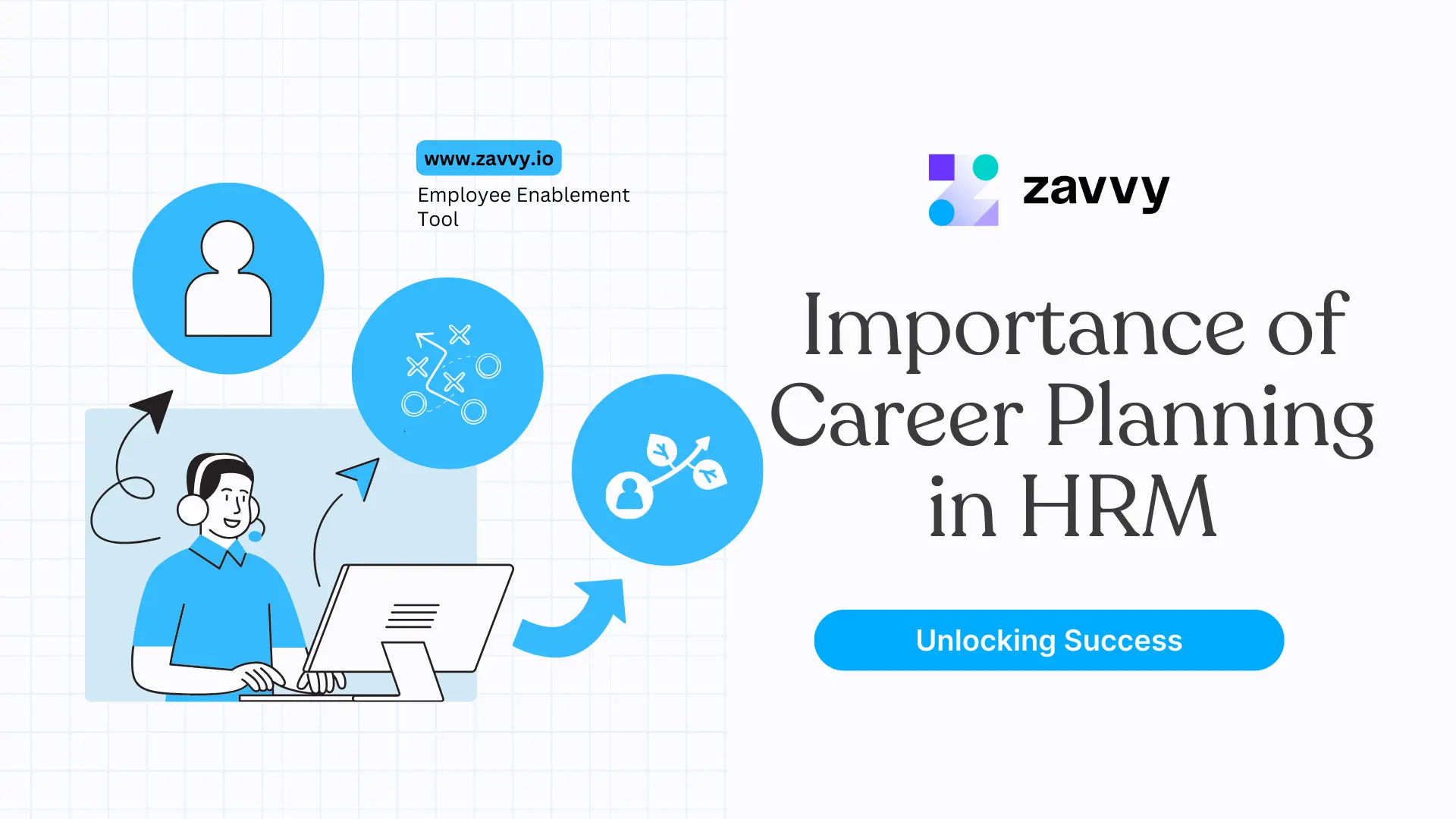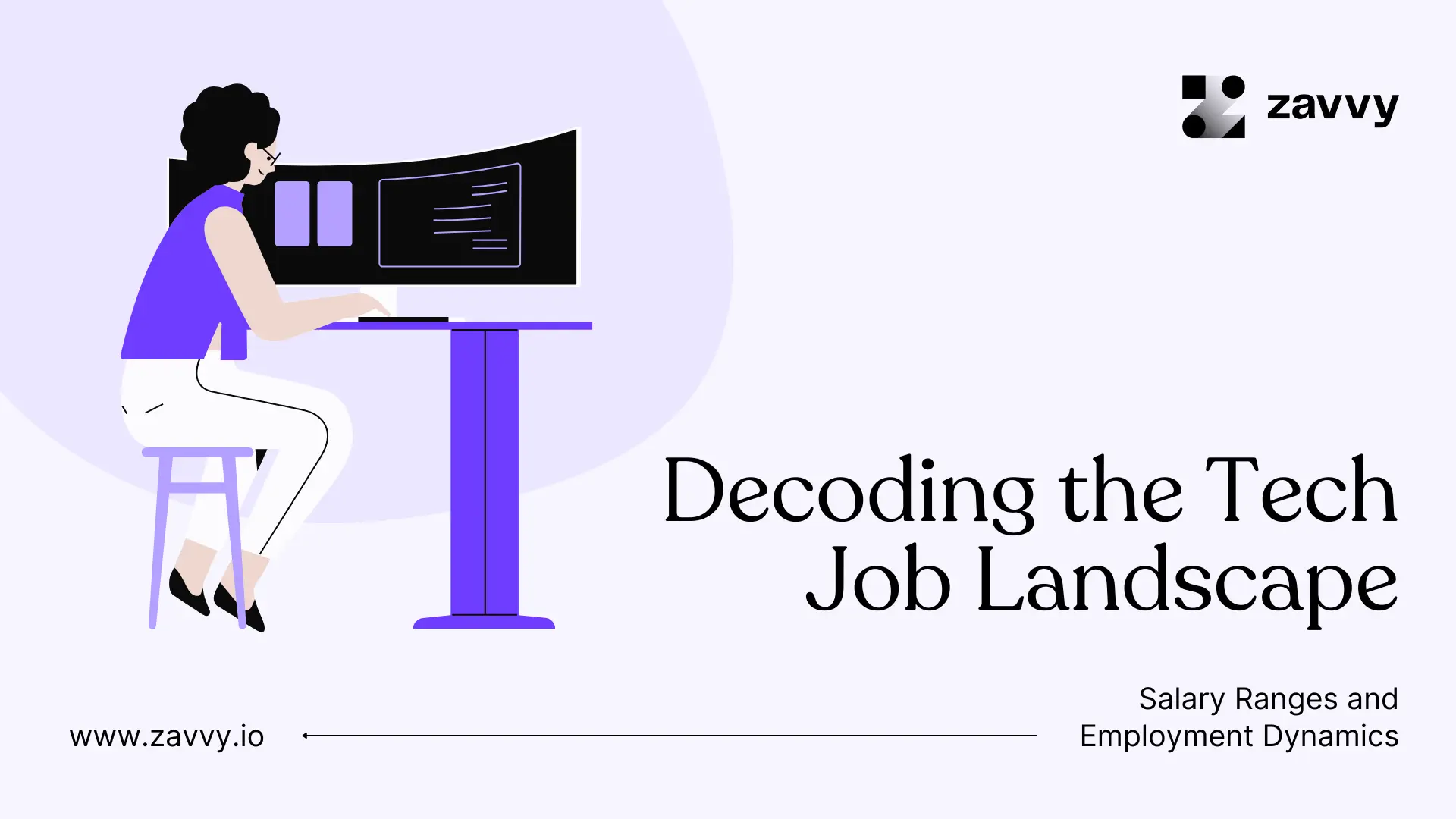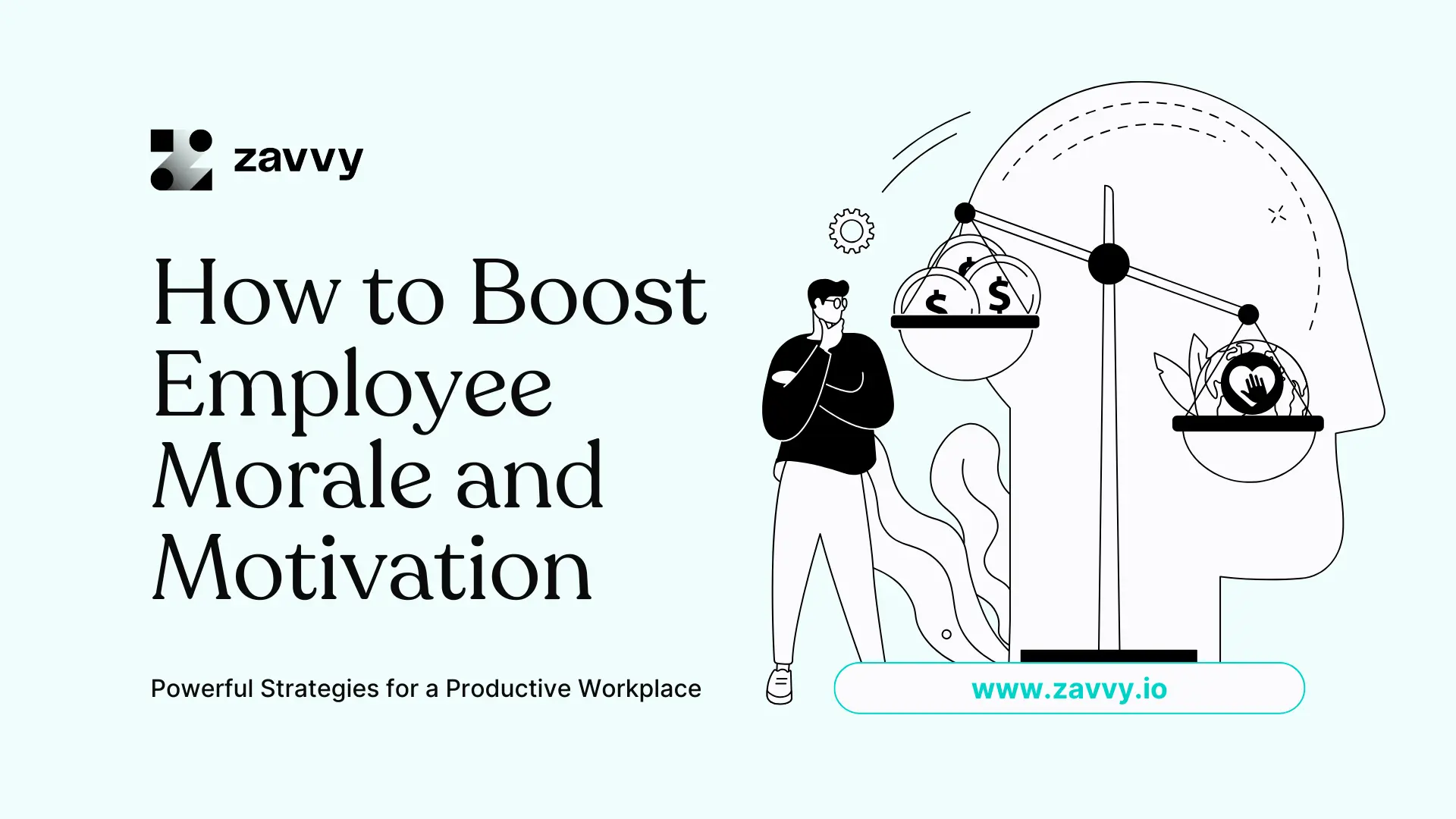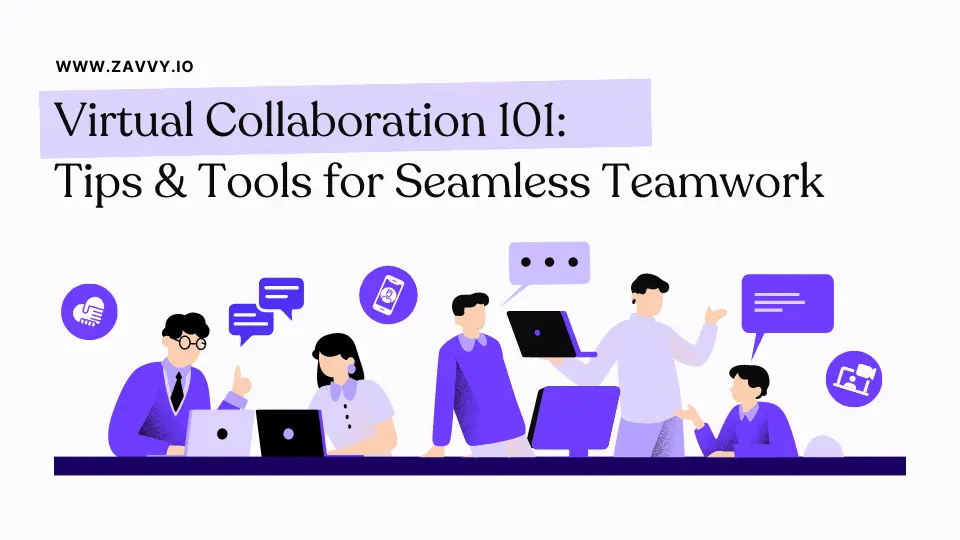
14 Competency Model Examples to Clarify Expectations and Growth for Your Employees
Zuletzt aktualisiert:
18.3.2024
Lesezeit:
14 minutes
última actualización
18.3.2024
tiempo de lectura
14 minutes
Last updated:
March 18, 2024
Time to read:
14 minutes

Are you tired of the disconnect, the confusion, the missed marks in employee performance?
Competency models. They're not just HR jargon. They're the roadmap to clarity in the convoluted jungle of performance expectations:
- They are what translate organizational goals into individual achievement.
- They provide a clear roadmap by defining the essential skills, behaviors, and knowledge requirements needed for success within each role in your org chart.
- They're the language that everyone in your company can understand, from the intern to the CEO.
This article will showcase 14 real-world competency model examples that companies from various industries have deployed to stellar effect.
These aren't hypotheticals. They're actual blueprints companies use to unlock their teams' full potential.
We'll also unravel the best practices from all these examples to guide you when building your own competency frameworks.

🌟 What does an effective competency model look like?
Competency models are valuable tools for clarifying expectations and guiding employee evaluation and development.
They build upon job descriptions by focusing on the skills, knowledge, and behaviors needed for successful performance in a particular job role.

Although job competency models may differ from company to company or even the role and level of seniority, you can typically expect the framework to include the following:
- Key competencies: A list of skills or workplace competencies required for a particular role or team, for example, expertise in interpersonal, communication, or technical skills. These are the building blocks of a robust competency model and should align with the company's values and strategic goals.
- Proficiency levels: A scale or grading system to rate the competency level, for example, basic, intermediate, advanced, proficient, and expert. This allows for a more nuanced performance evaluation of an employee's performance and development needs.
- Behavioral indicators: A description of each competency that simplifies performance assessments (enabling competency-based appraisals). These indicators can be observed behaviors or actions that demonstrate the skill or knowledge level for a particular competency. This also helps employees understand what is expected of them and how they can work towards improvement.
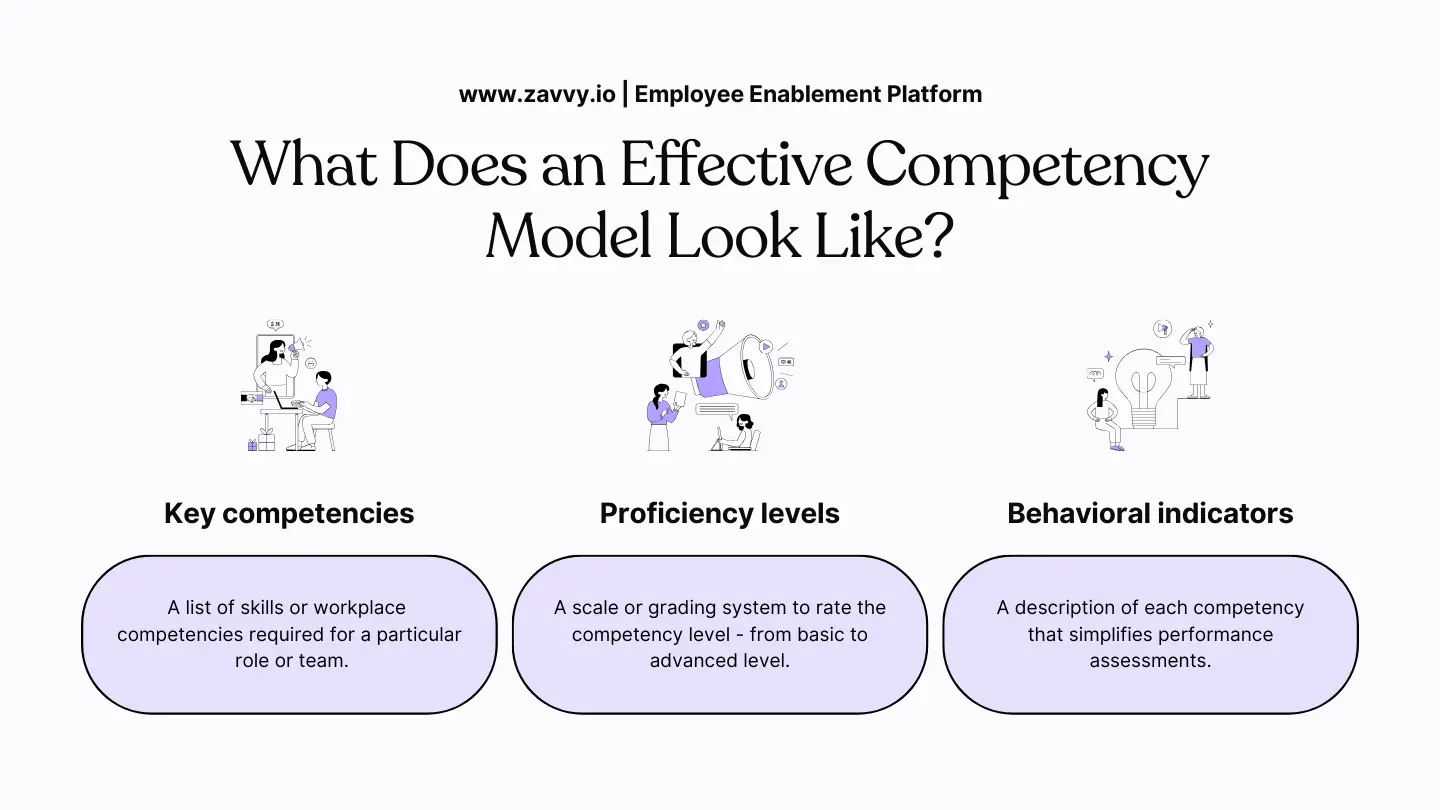

🏢 Industry-specific examples of competency models
So, what do competency matrix examples look like in the wild? Check out how companies in different fields adapt a basic framework to incorporate the critical competencies required in their respective fields:
🤝 HR competency model example
Human Resources departments manage and support the company's most valuable asset: its employees.
An HR competency model is essential in defining what skills and behaviors HR professionals must possess to succeed in their roles.
McLean & Company identifies 19 HR competencies that suit most organizations, with proficiency levels of 1 as a beginner level up to 4 as an expert.

The individual competencies are as follows:
- program planning and development
- needs analysis
- conflict management
- facilitation
- managing through change and uncertainty
- customer focus
- dynamic learning mindset
- branding and marketing (including branding of the employee value proposition)
- technology enablement
- influence
- relationship building
- business and financial acumen
- data literacy
- organizational awareness
- communication
- inclusion
- problem-solving and decision-making
- coaching
- project management
- technical HR expertise
➡️ Learn more about Human Resource competencies in our definitive guide.
🖥️ Engineering competency model examples
Engineering roles require specialized technical skills but also proficient communication, problem-solving, and project management abilities.
Depending on the role, some may also require managerial competencies.
The Engineering Competency Model from the United States Department of Labor
The Engineering Competency Model from the Employment and Training Administration of the United States Department of Labor is structured as a pyramid. The pyramid is broken down into five tiers, each representing a different category of competencies essential for a successful career in engineering.

Tier 1: Personal effectiveness competencies
This tier is the foundational layer and focuses on essential personal attributes in any profession. The competencies listed here are:
- interpersonal skills
- integrity
- professionalism
- initiative
- adaptability & flexibility
- dependability & reliability
- lifelong learning
Tier 2: Academic competencies
These competencies highlight the academic knowledge and skills necessary in engineering. They include:
- reading
- writing
- mathematics
- science & technology
- communication
- critical & analytical thinking
- computer skills
Tier 3: Workplace competencies
This tier focuses on the abilities and skills required to function effectively in a professional environment. The competencies are:
- teamwork
- client/stakeholder focus
- planning & organizing
- creative thinking
- problem-solving, prevention & decision making
- seeking & developing opportunities
- working with tools & technology
- scheduling & coordinating
- checking, examining & recording
- business fundamentals
Tier 4: Industry-wide technical competencies
This level addresses broader technical competencies applicable across the entire engineering field. The competencies listed are:
- foundations of engineering
- design
- manufacturing & construction
- professional ethics
- business, legal & public policy
- sustainability & societal & environmental impact
- engineering economics
- quality control & quality assurance
- safety, health, security & environment
Tier 5 - Industry-sector functional areas
- This top tier focuses on specific functional competencies within particular engineering industry sectors. The competencies here are to be specified by industry representatives.
On the two sides of the pyramid, there are also two overarching categories:
- Management competencies: These are managerial skills, including staffing, delegating, networking, mentoring, strategic planning, and more.
- Occupation-specific requirements: The competencies here pertain to requirements unique to specific engineering roles.
Overall, this competency model provides a comprehensive framework of the knowledge, skills, and abilities needed for a career in engineering, starting from basic personal traits and progressing to specialized industry-specific capabilities.
The example below is used as a framework for the following people in engineering:
- Industry leaders, employers, and HR professionals to identify skill needs.
- Educators and academics to inform training and curriculum development.
- Workforce professionals and career counselors to develop resources for career exploration and guidance.
- Current and future engineers to understand the skills and abilities required to enter, advance, and succeed in the industry.
Software engineer competency and leveling matrix
This software engineer competency and leveling matrix developed by Bradford Fults defines the competency model across 7 levels of engineering expertise:
- Software Engineer I (L1)
- Software Engineer II (L2)
- Software Engineer III (L3)
- Staff Software Engineer (L4)
- Senior Staff Software Engineer (L5)
- Principal Engineer (L6)
- Senior Principal Engineer (L7)
This software engineering competency model categorizes competencies into main groups:
- software design & implementation
- team collaboration & advice
- ownership & accountability
- brand & relationships
- innovation
- vision
- integrity & ethics
- leadership
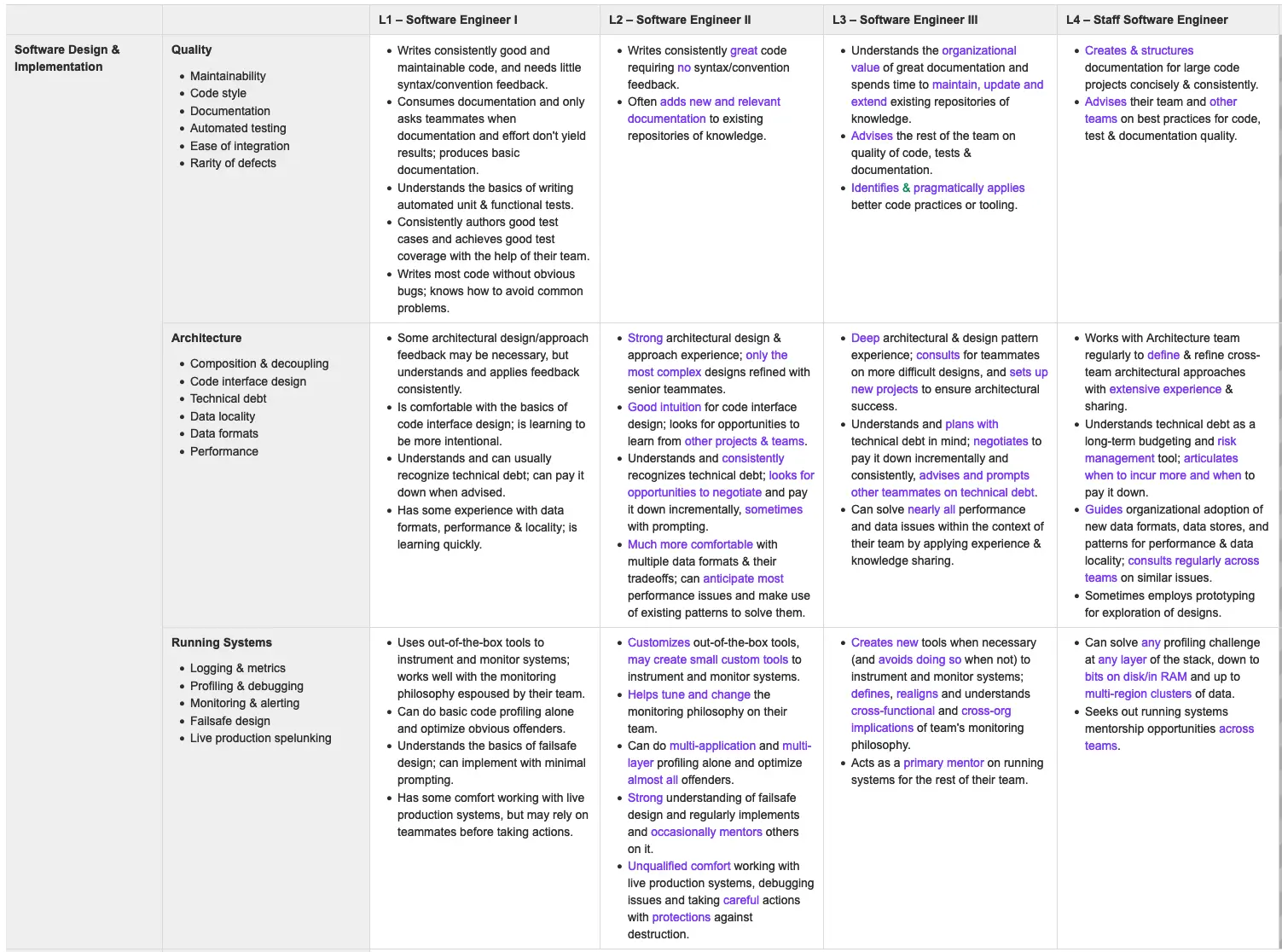
Each group further details competencies, creating a structured framework to guide engineers through different stages of their career development:
Software design & implementation:
- quality
- architecture
- running systems
Team collaboration & advice:
- project & team scope
- technical collaboration
- communication & empathy
Ownership & accountability:
- productivity, time & task management
- project accountability
- production supports
- autonomy & self-starting
Brand & relationships:
- product & business team relationships
- engineer team relationships
- external representation
Innovation:
- contributing to product enhancements
- driving efficiency of systems & practices
- collaborating on patents
Vision:
- technical strategy mapping
Integrity & ethics
- fiscal responsibility
- privacy & security
- honesty & accuracy
Leadership
- mentorship & guidance
- broadcasting & knowledge sharing
- influence & alignment
🎨 Marketing competency model examples
Marketing is crucial for promoting any organization, and anyone working in this role requires a blend of technical skills, soft skills, interpersonal abilities, and creativity.
HRSG sample marketing competencies
HRSG divides its marketing competencies into specific categories.
For example, anyone starting a career in digital marketing or growing in the field will meet one of the following five proficiency levels:
- Introductory: Demonstrates a rudimentary understanding and ability and, with guidance, applies the competency in a few simple situations.
- Basic: Demonstrates basic knowledge and ability and can apply the competency in common situations that present limited difficulties.
- Intermediate: Demonstrates solid knowledge and ability and can apply the competency with minimal or no guidance in the full range of typical situations.
- Advanced: Demonstrates advanced knowledge and ability and can apply the competency in new or complex situations.
- Expert: Demonstrates expert knowledge and ability and can apply the competency in the most complex situations.

The "Marketer Pathways" competency model
The "Marketer Pathways" competency framework from the Marketing Institute of Ireland groups competencies into 3 buckets:
Business competencies - fundamental
These competencies are relevant to all marketers regardless of their role or industry sector. Different levels will be expected depending on the career stage of particular roles.
These competencies address practical business knowledge and skills necessary for achieving business goals, emphasizing a broader organizational understanding and commercial awareness.
The competencies of this group are:
- action & results
- change & improvement
- commercial awareness
- ethics & integrity,
- decisions & judgment
- innovation
- organizational awareness
- planning & prioritization
- project management
Marketer competencies - technical
These marketing-specific competencies are essential for marketing professionals, covering a range of marketing specializations and technical skills.
Competencies include:
- integrated analytics
- brand
- marketing capability
- channel management
- corporate communications
- digital marketing
- marketing campaigns
- new product development
- marketing strategy
- research
- customer centricity

People competencies - behavioral
These competencies focus on interpersonal interactions, and leadership attributes essential for effective teamwork and people management across any industry. These behavioral capabilities are needed to effectively contribute to the achievement of business goals.
The people competencies of this marketing competency model are:
- communication & interpersonal skills
- conflict management
- developing people
- influencing
- leadership
- managing people
- negotiation skills
- relationship management
- resilience
- team building
For each of these competencies, they include:
- definition;
- behavioral indicators across five levels of mastery: basic, developing, solid, strong, exceptional;
- career stage (the point in a marketer's career where a specific level of competency is expected from 1 to 7, i.e., Graduate to CMO).
💰 Sales competency model examples
Sales competency models focus on the skills and behaviors needed to meet specific sales targets. They also consider the competencies required for different sales process stages, such as prospecting activities, qualifying leads, and closing deals.
These models may differ between industries, with some emphasizing technical or product knowledge while others prioritizing relationship-building skills.
Sales professional competency model from the Canadian Professional Sales Association
The CPSA Institute uses the diagram below to demonstrate the required competencies with professional sales conduct at the model's center.

The diagram showcases various concentric circles, each representing layers of sales competencies:
The outermost layer represents broad areas of sales functions:
- Prospecting
- Fostering client relationship
- Developing client-focused solutions
- Negotiating & closing
- Following up
The middle layer focuses on specific skill sets:
- Business acumen: Understand your company, client's business, financial and legal literacy.
- Sales process technology: Emphasizing the use of technology in sales processes.
The innermost layer highlights the core values and attributes every sales professional should exhibit:
- Integrity
- Drive results
- Teamwork
- Continuous learning
- Personal brand
All of these relate to the model's core: professional sales conduct.
For each competency, the model defines:
- Performance indicators: Marked with a "P," these indicators define the skills vital for effective practice in sales roles. The indicators evolve with the career stage: The average time on the job required to demonstrate performance indicators for a Sales Associate is 6 months. In contrast, the average time on the job required to demonstrate performance indicators for Sales Professionals is 4 years.
- Knowledge indicators: Denoted by a "K," these highlight the essential knowledge a sales professional should possess to perform the various aspects of their job.
Sales leadership competency model from the Canadian Professional Sales Association
The Sales leadership competency model from the Canadian Professional Sales Association defines 7 competency groups:
1. Sales planning:
- engage in strategic planning
- planning accounts, territories, and targets
- execute with excellence
2. Build and lead the sales team:
- staff planning
- recruit and select sales team members
- onboard sales team members
- recognize and incent sales performance
3. Coach for sales success:
- support sales enablement
- coach to the sales process
- coach for sales performance
4. Support the cycle of selling:
- establish sales process
- support strategic client relationships
- engage in sales communication
- support negotiations
5. Business acumen:
- understand your company
- understand your client's business
- demonstrate financial literacy
- demonstrate legal literacy
6. Sales technology:
- align sales technology to strategy
- leverage technology for data and decision making
- lead technological change in sales
7. Professional sales conduct:
- act with integrity
- drive results
- work as part of a team (collaboration)
- engage in continuous learning
- develop personal brand
Each competency is structured to represent both the performance and knowledge aspects essential for proficiency:
- Performance (P): These are the tangible actions, practices, and behaviors a sales leader should exhibit. They indicate the individual's capabilities to effectively apply their skills and knowledge in real-world scenarios.
- Knowledge (K): This encapsulates the theoretical understanding, insights, and information a sales leader should be familiar with. Knowledge informs the practical actions of the sales leader.
🏆 8 Best practices gathered from different types of competency models
Regardless of the industry, there are valuable lessons we can learn from other organizations' competency models. Heather Burright, Host of the Learning for Good podcast, explains her experience in this area and how she found it useful to research how other companies approach competency frameworks:
"I've worked both internally at a national nonprofit managing their proprietary competency model, and I've worked with other nonprofits to help them create and implement their own competency models as well. I want to see what other organizations are doing and where they're headed. How have they used their model, what is in their model and why, how did they get there, how are they using it?"
When looking at successful competency model examples from other companies, we noticed these common themes and best practices.

Ensure managers exercise judgment
Those in leadership positions are critical in defining job-specific competencies for individual roles and assessing whether workers possess these necessary attributes during employee performance management cycles.
The University of Newcastle, Australia, uses a Capability Matrix handbook for all its professional staff. The matrix outlines the five foundational competencies required by each staff member, including:
- Communication and engagement
- Organizational planning and project management
- Professional and technical expertise
- Business understanding and business intelligence
- Creative and strategic thinking

Crucially, though, managers and leaders are urged to "exercise their judgement in applying the Capability Matrix as not every action statement will apply to an individual's role."
This guidance ensures that competencies are tailored appropriately.
Define expectations following onboarding
Intercom clearly defines the competencies required for different levels of expertise and maps them to different roles.
For example, a "Practitioner" must understand product knowledge thoroughly and consistently use the company's voice.

One thing that stands out in Intercom's competency framework is they have a category for Beginner, which kicks in following onboarding completion. This ensures that new joiners clearly understand what they need to demonstrate on arrival at the company.
Implement a consultative process
The Organization for Security and Co-operation in Europe (OSCE) uses a competency framework that clearly separates managerial competencies from core requirements. This decision results from a rigorous consultative process led by the Department of Human Resources in the OSCE Secretariat, based on 700 survey responses and 83 OSCE officials participating in focus groups.
By involving a broad range of opinions in the process, OSCE has produced a well-rounded, dynamic framework that considers the unique needs of different departments and positions.
Define the foundational performance management criteria
IBM's Data Science Skills competency model is a blueprint for data scientist professionals. The document outlines the foundational competencies and performance criteria required to excel in this role.

This ensures that performance appraisals are always based on objective criteria and that employees understand what their employer expects from the outset.

Create job families and allocate competencies
The Organisation for Economic Co-operation and Development (OECD) classifies every role into one of three job families:
- Executive Leadership
- Policy Research, Analysis, and Advice
- Corporate Management and Administration

The OECD uses these job families to establish corporate-level job requirements for positions with similar roles. This system also identifies potential matches and opportunities for in-house mobility, offers corporate learning prospects, and forms the foundation for structured career development programs.
Incorporate company-wide initiatives into competency frameworks
Diversity, equity, inclusion, and belonging are increasingly important facets of organizational culture. The Conference Board has implemented a competency model specifically for its Diversity and Inclusion practitioners to ensure that employees are fully supported.
The competencies required include:
- Change management
- Diversity, Inclusion, and Global Perspective
- Business Acumen
- Strategic external relations
- Integrity
- Visionary and strategic leadership
- HR competencies
By building competencies around an important organizational initiative, companies can ensure that the necessary skills and behaviors are integrated into all areas of their operations.
Use competencies in recruitment
Competencies are commonly associated with performance management. However, the best way to ensure your employees meet expectations is to select the right candidates during the hiring process.
Companies like UNESCO bake competencies into recruitment, with its competency framework policy explaining,
"Using competencies for recruitment ensures that any selection process is focused on the behaviors that are important for success in the role. It also ensures that new staff share UNESCO's values. Interview panels will include questions around competencies, enabling evaluation of candidates against common, specific indicators. A competency-based interviewing guide will be provided to the members of interview panels."
Keep competencies relevant
Competencies should never be a one-and-done exercise. Revisiting your competency models is essential to ensure they remain relevant. As Heather Burright explains,
"One of the first things I do when working on a competency model project is analysis. I look into the future of work, so anything I come up with is forward-looking; where is the world headed, where are organizations headed, and what are the competencies that are most important to get us there?"
Deloitte is an example of a company that keeps up with the times by mapping competencies to relevant trends. For example, its Digital Era competency framework considers the impact of automation on employees, companies, and education.

📝 2 Ready-to-use competency model templates
Now you know the best practices and benefits of competency models, creating your own needn't be daunting.
Zavvy offers two ready-to-use templates to kickstart the creation of your custom competency model.

Whether you're looking to map out the essential competencies required for leaders, individual contributors, or specialists in your organization, our templates are the perfect starting point.

➡️ Download our competency matrix templates or our leadership competency model to begin.
➡️ Clarify, motivate, and develop your people with competency models. With Zavvy
Your employees aren't just part of your organization; they ARE your organization. They thrive on clear expectations and the opportunity to grow, something a well-crafted competency model provides.
But we know how much time and effort it takes to develop competency models, especially a comprehensive company-wide competency model.
Elevate your team's potential and bring clarity to their roles with transformative competency models — all through the power of Zavvy:
- Create role-based competency models to create structure and transparency in your company.
- Implement competency-based career progression frameworks and show employees what they need to get to the next level of their careers.
- Run competency-based performance evaluations to define your people and team's competency profiles and identify skill gaps.
- Bridge skill gaps with competency-based training. The thousands of learning resources on Zavvy have competency tags, so your people will find the right training materials for their roles and needs.
But Zavvy is more than a tool. We are a partner for creating a framework that can create transparency, motivation, and growth in your organization. Our specialists discuss and train all our customers about selecting core competencies, mapping competencies to roles, you name it.
📅 Talk to our experts about creating a custom competency model for your organization.

❓ FAQs
Still have questions about competency models? We've got you covered.
What are the benefits of using a competency model?
A functional competency model clearly explains the skills and behaviors required for employees to excel in their roles. This framework supports recruitment, onboarding, performance management, and employee development. It also creates a unified language and expectations across departments and levels and will identify any existing competency gaps.
How often should competency models be updated?
Employers should review their competency models at least annually to ensure alignment with changing business strategies and objectives. To retain a competitive advantage in the marketplace, updating them whenever a significant change occurs within an organization, such as mergers or acquisitions, is also essential.
How can I create a well-designed competency model for my company?
Creating a draft competency model can be overwhelming, but it doesn't have to be. Zavvy offers ready-to-use templates, allowing you to customize your competency model easily.
How do I ensure that my competency model is effective?
Involving all stakeholders in the creation process and gathering feedback is crucial to ensuring your competency model is effective. This might include employees, managers, subject matter experts, and HR professionals. Remember to regularly review your competency model to ensure it aligns with organizational goals and objectives.
Read next
Als Nächstes lesen
No items found.
No items found.
.png)
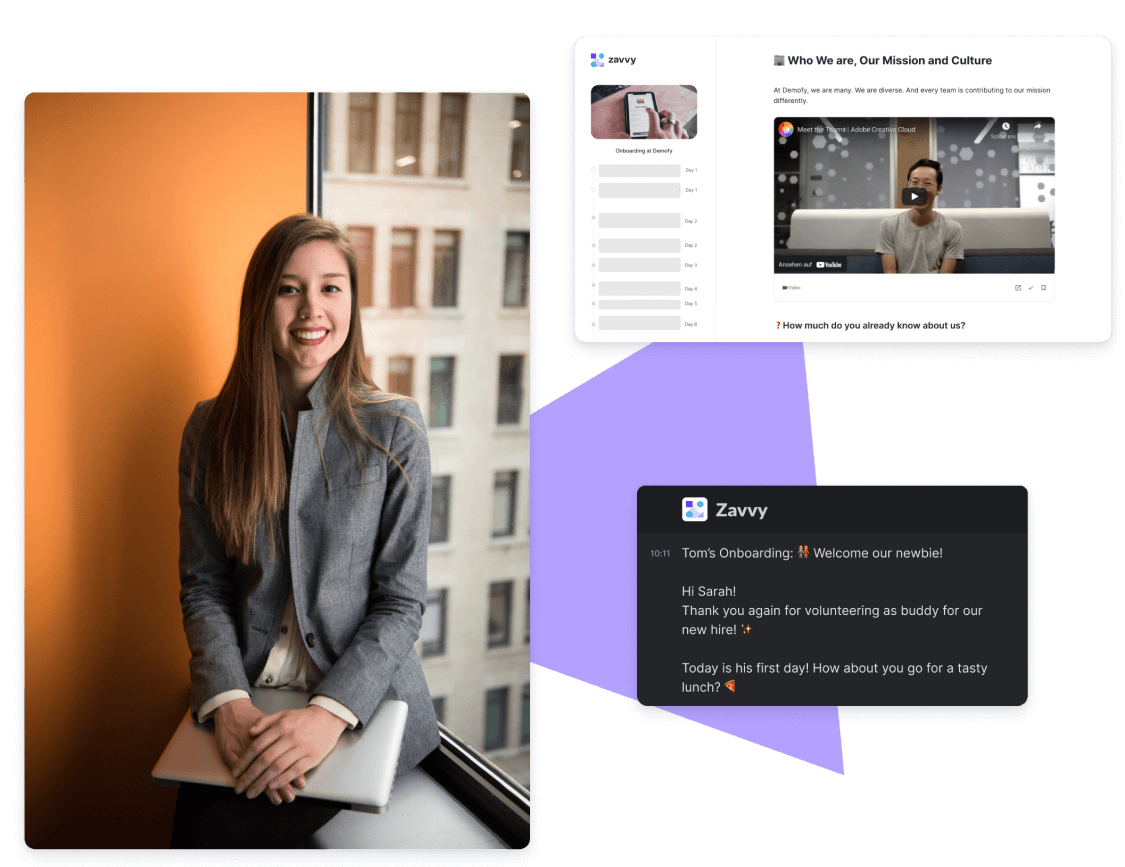



















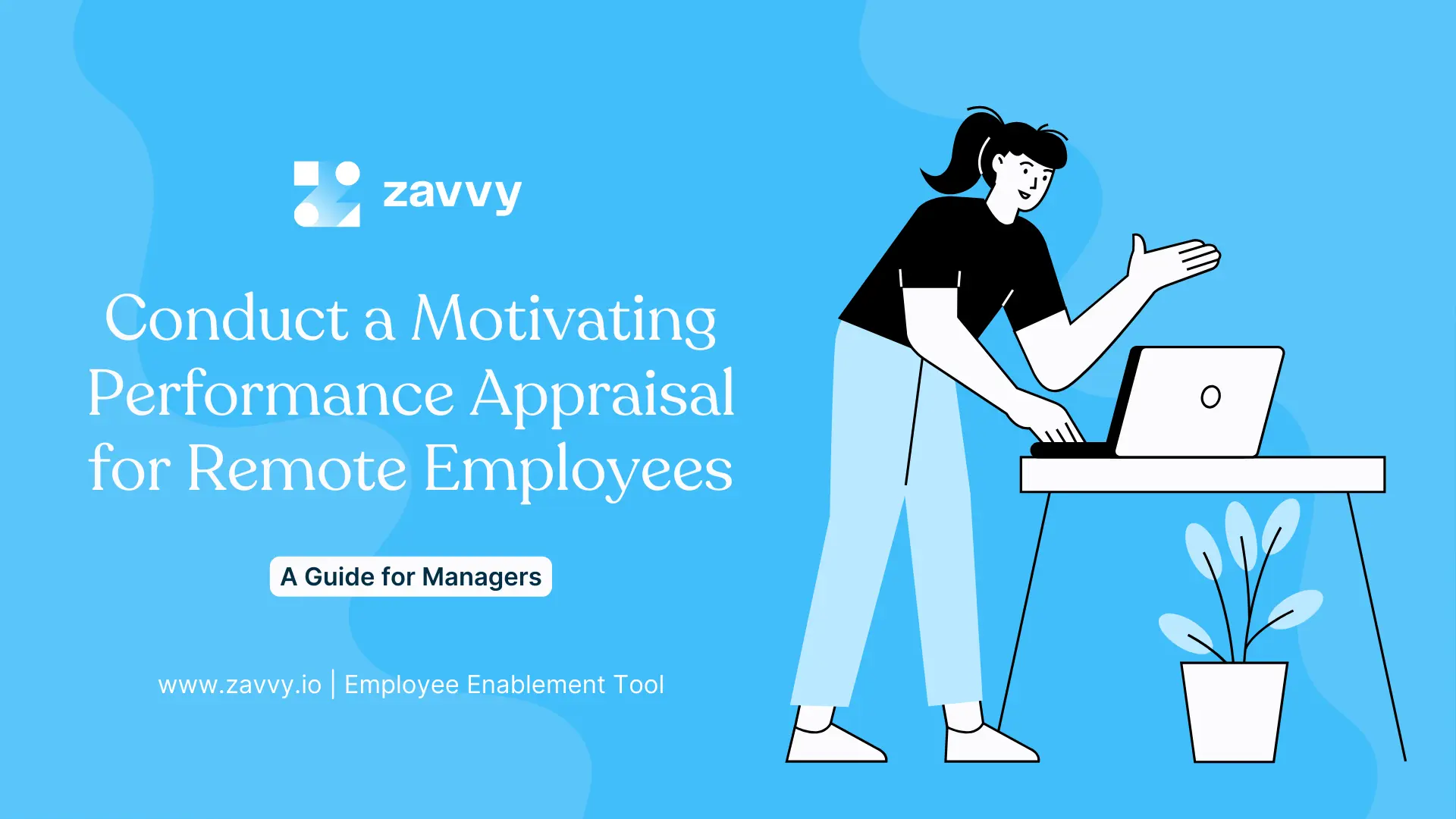
.png)







